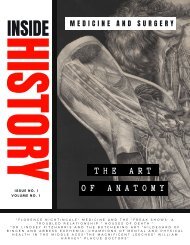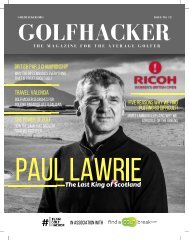Inside History: Protest. Revolt & Reform
For our next issue we take a closer look at the theme of Protest from the events of Peterloo to the fall of the Berlin. Inside we cover a whole range of historical protests and the individuals who led the charge for change. This issues includes: John Brown's raid on Harpers Ferry, The Suffragettes, Billie Holiday and the role music has played in protests, The Civil Rights Movement, Protest and Sport, We are the People: The Fall of the Berlin Wall, Bloody Sunday at Trafalgar Square, and much much more.
For our next issue we take a closer look at the theme of Protest from the events of Peterloo to the fall of the Berlin. Inside we cover a whole range of historical protests and the individuals who led the charge for change. This issues includes:
John Brown's raid on Harpers Ferry, The Suffragettes, Billie Holiday and the role music has played in protests, The Civil Rights Movement, Protest and Sport, We are the People: The Fall of the Berlin Wall, Bloody Sunday at Trafalgar Square, and much much more.
- No tags were found...
Create successful ePaper yourself
Turn your PDF publications into a flip-book with our unique Google optimized e-Paper software.
19th Century
of the workhouse and Nichols was described as the
‘worst women in the Square and very disorderly at the
station’; in August 1888 she was the first victim of Jack
the Ripper.
A few days earlier there had been another Sunday visit to
Westminster Abbey; this time starting at the radical hub
of Clerkenwell and finishing in Trafalgar Square, filling it
up with protest again. In between the mob/ protestors
managed to gain access to the Abbey this time; some
posed on pedestals; others smoked tobacco, smirked
and called out randomly; most refused to remove their
hats and spat on the floor. Canon George Prothero
(Harrow and Oxford) produced a finely balanced sermon
where he called for both punishments for the sinful and
state intervention to help the poor.
Sir Charles Warren had had enough. On November 8 he
requested/ insisted that the Conservative Home
Secretary, Herbert Matthews, banned all public meeting
and speeches from being held in Trafalgar Square, thus
adding another level of protest- it now became an issue
of free speech and assembly. His legal case was that it
was Crown property. This was a little dubious and led to
an immediate call for a demonstration on Sunday 13
November, with the dual purpose of protesting about
the treatment of Irish Nationalist MP William O’ Brien and
establishing the right to hold a meeting at Trafalgar
Square.
A demonstration was called for 4pm with speeches from
Hyndman, Burns and another radical leader Robert
Cunninghame Graham, probably the first socialist to be
elected to the Commons. It’s hard to see how they
expected to be successful. It was an attempt to occupy a
space already controlled by a well armed police force
with military back-up. The authorities would also know
exactly the routes the protesters would use. These
marches to the Square were also banned, which gave
the police a pretext to use violence on those in transit.
As Morris said- ‘so we walked into the net’. Victorian
radicals Annie Besant, Eleanor Marx, George Bernard
Shaw walked with Morris from Clerkenwell. They were
viciously attacked by a police baton charge at Holborn.
They made a rational decision and ran away; Shaw called
it ‘the most abjectly disgraceful defeat ever suffered by a
band of heroes’. William Morris also witnessed the
violence. He wrote that he ‘was astounded at the rapidity
of the thing and the ease with which military organisation
got its victory’
The Pall Mall Gazette reported that the Clerkenwell
contingent had no weapons, not even sticks. Even if they
were armed, and there was some retaliation by the
crowd later in the day, it would not have mattered. All
those radicals, nationalists and socialists who were
present received an object lesson in the power of a
confident, prosperous state with a monopoly on
violence. Hyndman, the hero (in his own mind) of the
West End riots was lost in the crowd and became an
anonymous victim, and John Burns was assaulted, and
arrested. Cunninghame Graham, like Burns, made it to
the Square but was assaulted by the police and beaten
up.
Those protestors- at least 10,000- who reached the
square suffered even worst treatment. At around 4pm
they were set upon by the police; cloaks covered the
numbers on their shoulders even if they could have been
identified in the chaos. Behind the police were mounted
cavalry, who broke into the mostly stationary lines of
protesters and then the police baton-charged them. It
was indiscriminate; even those who were running away
were followed and attacked. Some were crushed against
shop shutters in the Strand when they had nowhere else
to run. There was no attempt to engage, persuade or
offer routes to escape.
Many of those standing around were victims. Two
hundred people at least were injured, with many others
refusing to go to hospitals because of possible reprisals.
At least two people died as an indirect result of injuries
sustained. Swords were not drawn and the soldiers were
not told to open fire; so there were no deaths on the
day. However, the Life Guards did attack with fixed
bayonets. The day did not quite turn into Peterloo, but it
deserved its name, quickly acquired, of ‘Bloody Sunday’.
The next day the legal system rolled into action; 70
individuals were in front of the same Sir James Ingram
who had offered the unemployed nothing but the
workhouse. Later the same week, 20,000 special
constables were sworn in. Burns and Cunninghame
Graham served six weeks in Pentonville.
Most of the newspapers supported the police. Apart
from radical voices like the Pall Mall Gazette and
20 INSIDE HISTORY

















